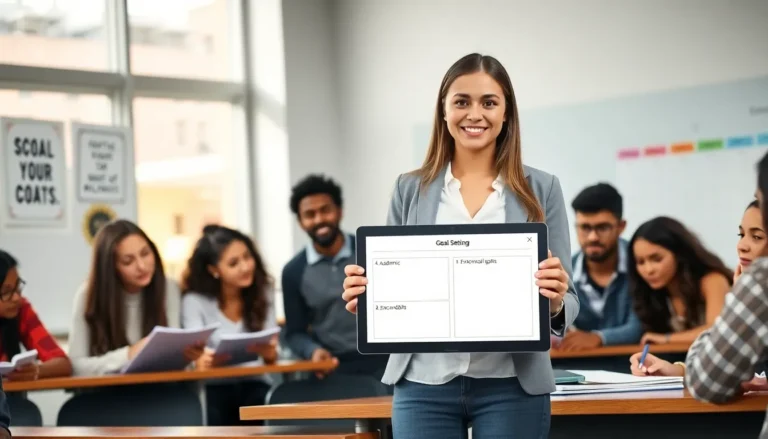Table of Contents
TogglePicture this: you’re out and about, your iPhone’s battery is gasping for life, and your friend’s phone is practically bursting with power. What if you could turn that situation into a lifeline? Enter the world of charging your iPhone with another iPhone. It’s like sharing a slice of pizza, but instead, you’re sharing that sweet, sweet battery juice.
Understanding iPhone Charging Methods
Charging methods vary, offering flexibility in how iPhones receive power. Two primary methods exist: traditional charging and wireless charging options.
Traditional Charging Methods
Charging an iPhone typically involves using a Lightning cable. Users connect one end of the cable to the iPhone and the other end to a power adapter or USB port. Power adapters come in various wattages, with the most common being 5W or 20W. Fast charging is available with compatible adapters, allowing 50% battery in approximately 30 minutes. Utilizing portable power banks offers an alternative for on-the-go users. Charging from a laptop or desktop computer also adds flexibility for users without access to a wall outlet.
Wireless Charging Options
Wireless charging for iPhones relies on Qi technology. Devices equipped with this feature allow for charging by placing the iPhone on a compatible charging pad. Charging pads vary in output, typically offering 5W to 15W for faster options. While using wireless chargers, it’s essential to align the iPhone correctly for optimal power transfer. Certain models also support MagSafe, enhancing alignment and efficiency. Users appreciate the convenience of wireless charging, eliminating the need for physical connectors.
Using One iPhone to Charge Another
Charging one iPhone with another is a practical solution during emergencies. This method enables users to extend their device’s usage without relying on traditional power sources.
Requirements for Charging
Proper equipment is essential. Both iPhones must support the feature, typically available from iPhone 8 and later models. A Lightning cable is necessary to facilitate the connection. Additionally, the charging iPhone needs a sufficient battery charge to supply power effectively. Devices must remain close to ensure optimal connection and efficiency.
Step-by-Step Guide to Charging
Start by connecting a Lightning cable to the device that will charge another iPhone. Next, plug the other end of the cable into the charging iPhone’s Lightning port. After establishing the connection, users should see a charging indicator on the receiving device. Adjustments may be necessary to ensure the cable remains secure during the process. Finally, monitor both phones for battery levels to avoid complete depletion.
Tips for Optimal Charging
Users should confirm both devices are compatible and charged adequately before starting. Keeping the charging iPhone stationary enhances connection stability. Selecting appropriate charging cables contributes to efficient power transfer. Additionally, turning off any resource-intensive apps on the receiving phone helps speed up charging. Finally, consider positioning both devices on a flat surface to minimize disruptions and enhance charging effectiveness.
Potential Issues and Considerations
Charging one iPhone using another introduces potential challenges and important factors to consider. Understanding these concerns ensures a smoother experience.
Battery Drain Concerns
Battery drain presents a significant concern when sharing power between iPhones. The charging iPhone may experience a notable decrease in its power levels during the process, particularly if it’s already low on charge. Users should monitor the battery percentage closely to avoid completely depleting the charging device, which may lead to unforeseen complications. Keeping the charging iPhone connected to a power source can alleviate some drain issues, thereby extending its battery life while charging another device.
Compatibility with Different Models
Compatibility varies across iPhone models regarding the ability to charge another phone. Only iPhone 8 and later models support this feature, limiting options for users with older devices. Ensuring both devices meet this requirement is crucial for successful charging. Additionally, various software versions may affect functionality, so checking for the latest updates ensures optimal performance. Users should confirm that the necessary accessories, including reliable Lightning cables, are available, as these factors directly impact compatibility and charging success.
Alternatives to Charging with Another iPhone
Exploring alternatives to charging an iPhone with another iPhone showcases various practical methods available to users. Traditional wall chargers come as a reliable option; these chargers provide a consistent power source through a Lightning cable connected to an outlet. Users can also utilize portable power banks. Power banks are portable and can charge iPhones multiple times, making them ideal for travel.
Wireless charging pads offer an innovative way to charge devices without cables. Qi-compatible pads allow users to place their iPhones directly on the pad for effortless charging. Some models, like those offering MagSafe technology, increase efficiency for compatible iPhones through magnetic alignment.
In addition to these methods, car chargers represent another feasible solution. Car chargers plug into vehicle power outlets, turning the car into a mobile charging station. This convenience helps users maintain battery levels while traveling.
Solar chargers present an eco-friendly alternative. These chargers harness solar energy, making them suitable for outdoor enthusiasts or those in remote areas. With varying power capacities, users must select a solar charger that meets their device’s needs.
Using a charging case is also a smart choice. Charging cases allow users to carry a power reserve integrated into the case itself. This solution combines protection with extra power, benefiting busy individuals on the go.
Additionally, sharing chargers among friends can help during emergencies. Whether at home or out and about, two iPhone users with compatible chargers can easily assist each other. Prioritizing communication ensures both parties remain connected without compromising battery life.
Each method provides flexibility and convenience for charging needs, enhancing smartphone usage in various situations.
Charging an iPhone with another iPhone offers a practical solution in times of need. By understanding the requirements and methods involved, users can effectively extend their device’s battery life without relying solely on traditional power sources. It’s crucial to monitor battery levels and consider the implications of sharing power, especially if the charging iPhone is already low on battery.
Exploring alternative charging options further enhances flexibility for users. Whether opting for portable power banks or wireless charging pads, having multiple solutions ensures that staying connected is always possible. With the right knowledge and tools, users can navigate their charging needs confidently and efficiently.




